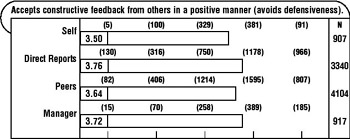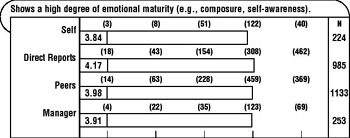Appendix B: Item Graphs
|
The following graphs show the results for a specific question or item from 360-degree assessments. These results, provided by Assessment Plus, were used to derive the statistics presented in this book. In deriving the statistics, I considered anything less than a rating of 4 or 5 as an indication that improvement could still be made. Leaders I have coached are not usually satisfied with assessment scores of 1–3, especially on items that measure such crucial behaviors of integrity and credibility.
Each graph, which is paired with the statistics presented in previous chapters, shows results by four rater groups: self, direct reports, peers, and manager. The first graph includes a key of explanation.
-
“In leadership assessments, over 50 percent of almost 13,000 peers and direct reports felt their leaders could improve in being honest and ethical” (see Chapter 2; see also Figure B-1).

Figure B-1:-
TITLE LINES. These lines show results by rater group. In this example, responses from the participant’s direct reports, peers, manager, and the participant (labeled as “Self”) are shown.
-
MEAN BAR. The bars depict the average of the responses for each rating group.
-
DISTRIBUTION. The numbers in parentheses above each mean bar depict the number of responses provided for each point on the rating scale for that particular rater group.
-
VALID N. This column indicates the total number of raters in each group who responded to the item.
Various scales were used:
Scale A (most data use this scale):
1 = significant improvement needed (or weakness)
2 = slight improvement needed
3 = skilled/competent
4 = talented
5 = role model
Scale B:
1 = significant improvement needed
2 = slight improvement needed
3 = meets leadership competency
4 = particularly talented
5 = outstanding
Scale C:
1 = highly dissatisfied
2 = dissatisfied
3 = neither satisfied nor dissatisfied
4 = satisfied
5 = highly satisfied
Scale D: The following 6-point scale was used on the item “Deals with issues in a candid manner (no hidden agendas)”:
1 = unacceptable
2 = needs improvement
3 = developing skill
4 = competent
5 = talented
6 = role model
-
-
“In recent assessment surveys, only 26 percent of more than 4800 employees were highly satisfied with their leader’s performance in communicating in a direct and straightforward manner” (see Chapter 2; see also Figure B-2).

Figure B-2: -
“In leadership surveys of 559 managers, 86 percent of 6023 of their followers and peers said that those leaders could improve at regularly asking for feedback” (see Chapter 3; see also Figure B-3).

Figure B-3: -
“In surveys, 95 percent of leaders were unable to give themselves the highest rating at demonstrating an understanding of their own strengths and weaknesses, and 98% of their bosses agreed” (see Chapter 3; see also Figure B-4).

Figure B-4: -
“Of 5612 executives, 79 percent said that their leaders could do better at promoting open and sincere communication” (see Chapter 3; see also Figure B-5).

Figure B-5: -
“Asked whether their leaders accept constructive feedback in a positive manner and without defensiveness, 76 percent of 7444 executives said that there is room for improvement, and 80 percent of those leaders’ bosses agreed” (see Chapter 3; see also Figure B-6).

Figure B-6: -
“Out of 2052 employees who participated in surveys, 68 percent said that their leaders could improve at working constructively under pressure, and 73 percent of those leaders’ bosses agreed” (see Chapter 4; see also Figure B-7).

Figure B-7: -
“When asked whether their boss displays a high degree of composure or emotional maturity, more than 60 percent of 2118 executives said that improvement was in order, and 73 percent of those leaders’ bosses agreed” (see Chapter 4; see also Figure B-8).

Figure B-8: -
“In surveys, more than half of 2197 people could not give their bosses the highest rating on being easy to talk to, and 76 percent of 1783 people said that their leaders were not entirely ‘authentic’” (see Chapter 5; see also Figure B-9).

Figure B-9: -
“Of 12,000 employees, 55 percent believed that a boss or coworker could improve in consistently keeping promises. And of more than 1100 leaders, 67 percent admit they have room for improvement in promise-keeping” (see Chapter 6; see also Figure B-10).

Figure B-10: -
“Of more than 1200 people surveyed in developmental assessments, 77 percent said that their leaders could improve at making realistic commitments” (see Chapter 6; see also Figure B-11).

Figure B-11: -
“Of 1784 employees who participated in leadership assessments, 75 percent said that their leaders do not always deal with issues in a candid manner, and 72 percent of those leaders’ peers agreed” (see Chapter 7; see also Figure B-12).

Figure B-12: -
“In surveys, 91 percent of almost 1000 leaders said that they need to improve in effectively handling team members whose behavior undermines teamwork or partnerships. Of 8229 of those leaders’ peers and direct reports, 79 percent agreed that there is work to be done” (see Chapter 7; see also Figure B-13).

Figure B-13: -
“In assessment surveys, 62 percent of leaders said that they could improve at admitting mistakes” (see Chapter 8; see also Figure B-14).

Figure B-14: -
“In developmental assessments, 88 percent of leaders admitted that they could improve in avoiding destructive comments, and 83 percent of their bosses agreed” (see Chapter 9; see also Figure B-15).

Figure B-15:“In developmental surveys, 75 percent of leaders’ peers said that improvement was in order in avoiding and discouraging destructive comments about other people and organizations, whereas only 58 percent of the same leaders’ direct reports agreed” (see Chapter 9; see also Figure B-15).
-
“When asked whether their leaders demonstrate appreciation of others’ concerns, feelings, motives, needs, and competencies, 79 percent of 7107 executives did not give their leaders the highest rating, and 91 percent of those executives’ leaders actually agreed” (see Chapter 10; see also Figure B-16).

Figure B-16:
|
EAN: N/A
Pages: 108